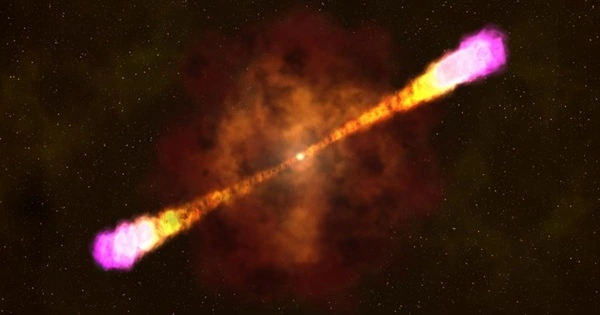Gamma-ray bursts (GRBs) are some of the most energetic and luminous explosions in the universe. They are thought to be caused by the collapse of massive stars or the merger of neutron stars, and are often associated with black holes. However, it is possible for GRBs to be caused by other mechanisms as well. For example, some GRBs may be produced by the collapse of extremely massive and rapidly rotating stars called magnetars.
There is still much that we don’t understand about the precise mechanisms that produce GRBs, and ongoing research is aimed at better understanding these mysterious and powerful explosions.
After new research shows that new-born supramassive stars, not black holes, are sometimes responsible for these massive extragalactic bursts of energy, space scientists may need to reconsider how gamma-ray bursts form.
Satellites orbiting Earth have detected gamma-ray bursts (GRBs) as luminous flashes of the most energetic gamma-ray radiation lasting milliseconds to hundreds of seconds. These catastrophic explosions occur billions of light years away in distant galaxies.
Our discovery gives us new hope for future sky surveys with telescopes like the Rubin Observatory LSST, which could detect signals from hundreds of thousands of such long-lived neutron stars before they collapse to become black holes.
Dr Nuria Jordana-Mitjans
A sub-type of GRB known as a short-duration GRB starts life when two neutron stars collide. These ultra-dense stars have the mass of our Sun compressed down to half the size of a city like London, and in the final moments of their life, just before triggering a GRB, they generate ripples in space-time — known to astronomers as gravitational waves.
Until now, space scientists have largely agreed that the ‘engine’ powering such energetic and short-lived bursts must always come from a newly formed black hole (a region of space-time where gravity is so strong that nothing, not even light, can escape from it). However, new research by an international team of astrophysicists, led by Dr Nuria Jordana-Mitjans at the University of Bath in the UK, is challenging this scientific orthodoxy.
According to the findings of the study, some short-duration GRBs are caused by the birth of a supramassive star (also known as a neutron star remnant) rather than a black hole.
According to Dr. Jordana-Mitjans: “Such discoveries are significant because they confirm that newborn neutron stars can power some short-duration GRBs as well as the bright emissions across the electromagnetic spectrum that have been detected in their wake. When looking for signals in the sky, this discovery could provide a new way to locate neutron star mergers and thus gravitational wave emitters.”

Competing theories
There is a lot of information available about short-duration GRBs. They form when two neutron stars collide after spiraling ever closer and constantly accelerating. A jetted explosion releases the gamma-ray radiation that causes a GRB, followed by a longer-lasting afterglow. The radioactive material that was expelled in all directions during the explosion produces a kilonova a day later.
However, it has long been debated what remains after two neutron stars collide — the ‘product’ of the collision — and thus the power source that gives a GRB its extraordinary energy. Thanks to the findings of the Bath-led study, scientists may be one step closer to resolving this debate.
Scientists in space are divided between two theories. According to the first theory, neutron stars merge briefly to form an extremely massive neutron star, which then collapses into a black hole in a fraction of a second. The second contends that merging the two neutron stars would result in a lighter neutron star with a longer life expectancy.
So the question that astrophysicists have been debating for decades is whether short-duration GRBs are powered by a black hole or the birth of a long-lived neutron star. To date, most astrophysicists have supported the black hole theory, agreeing that the massive neutron star must collapse almost instantly in order to produce a GRB.
Electromagnetic signals
Astrophysicists learn about neutron star collisions by measuring the electromagnetic signals of the resultant GRBs. The signal originating from a black hole would be expected to differ from that coming from a neutron star remnant.
The electromagnetic signal from the GRB explored for this study (named GRB 180618A) made it clear to Dr Jordana-Mitjans and her collaborators that a neutron star remnant rather than a black hole must have given rise to this burst.
Elaborating, Dr Jordana-Mitjans said: “For the first time, our observations highlight multiple signals from a surviving neutron star that lived for at least one day after the death of the original neutron star binary.”
“We were excited to catch the very early optical light from this short gamma-ray burst — something that is still largely impossible to do without using a robotic telescope,” said Professor Carole Mundell, study co-author and professor of Extragalactic Astronomy at Bath, where she holds the Hiroko Sherwin Chair in Extragalactic Astronomy. “However, when we examined our exquisite data, we discovered that we couldn’t explain it with the standard fast-collapse black hole model of GRBs.”
“Our discovery gives us new hope for future sky surveys with telescopes like the Rubin Observatory LSST, which could detect signals from hundreds of thousands of such long-lived neutron stars before they collapse to become black holes.”
Disappearing afterglow
What initially perplexed the researchers was the fact that the optical light from the afterglow that followed GRB 180618A vanished after only 35 minutes. Further investigation revealed that the material responsible for such a brief emission was expanding at close to the speed of light due to some continuous energy source pushing it from behind.
What was more surprising was that this emission bore the imprint of a millisecond magnetar, a newborn, rapidly spinning, highly magnetized neutron star. The team discovered that the magnetar after GRB 180618A was reheating the crash material as it slowed down. The magnetar-powered optical emission in GRB 180618A was a thousand times brighter than expected from a classical kilonova.





